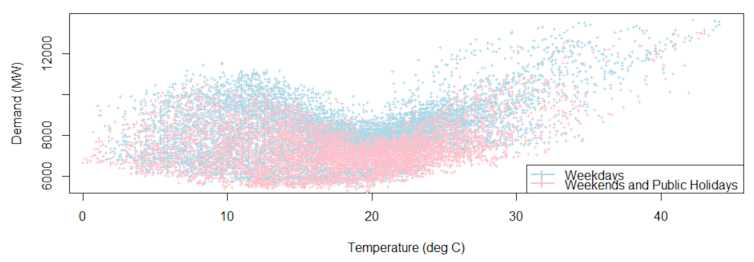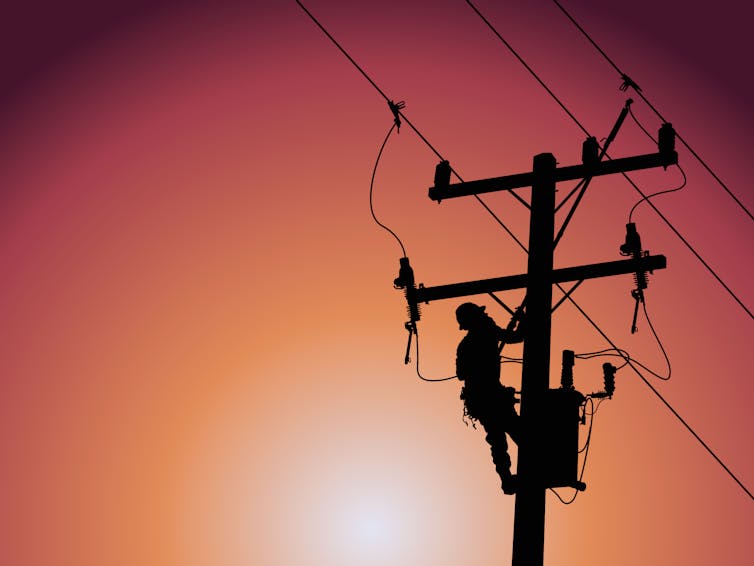Dylan McConnell, UNSW Sydney and Iain MacGill, UNSW Sydney
The Bureau of Meteorology this week declared a 70% chance of an El Niño developing this year. It’s bad timing for the electricity sector, and means Australians may face supply disruptions and more volatile energy prices.
El Niño events are associated with increased temperatures and heatwaves. These conditions drive demand for electricity, especially in summer.
These same conditions can also mean some generators don’t produce at full capacity. And unfortunately, the likely El Niño comes as the electricity sector grapples with other significant headwinds.
Australia’s electricity grid may be fine this summer. But given what’s on the horizon, it would be prudent to plan for the worst.
How does hot weather affect energy supplies?
Increased air conditioning use in summer can cause demand to peak, particularly during heatwaves, as the below graph shows.

AEMO
At the same time, electricity generators – including coal, gas, solar and wind – can become less efficient in hot temperatures, and so provide less energy to the system. And the hotter transmission lines get, the less electrical current they can safely carry. This lowers their capacity to transport energy.
When the electricity grid is under stress, this can lead to “load shedding” or blackouts – when power companies deliberately switch off the power supply to groups of customers to prevent the overall system from becoming dangerously unstable.
This happened in Victoria in early 2019, when more than 200,000 customers lost power during a period of extreme heat.
El Niño events are also associated with reduced rainfall. Among other effects on the electricity grid, this can reduce output from hydroelectricity generators (which produce electricity by pumping water through turbines). This occurred in Tasmania in 2016, and contributed to an energy crisis in that state.
Other headwinds are blowing
Aside from facing a likely El Niño, the electricity sector faces other headaches.
Earlier this year, the Australian Energy Market Operator warned electricity demand “may exceed supply” at times over the next decade due to factors such as weather conditions or generator outages.
The market operator pointed to delays to the Snowy 2.0 hydro project and the gas-fired Kurri Kurri Power Station, both in New South Wales.
The Kurri Kurri project has been delayed for a year. It was scheduled to begin operating in December this year – in time for the first summer since the Liddell coal-fired power station closed.
The Australian Energy Market Operator said the electricity system was expected to meet the “reliability standard” in all regions for the next five years. The standard requires at least 99.998% of forecast demand be met each year. Unmet demand can lead to interrupted supply, or blackouts.
But the operator also said delays to the Kurri Kurri project posed risks to reliability in NSW this summer.
Adding to the pressures on the system, Queensland’s Callide C coal-fired power station is still not back to capacity more than two years after an explosion at the site. The station’s owners last week announced the plant would not be fully operational until mid-2024.
Combine all this with a likely El Niño, and the electricity sector may be facing a challenging summer.
El Niño years are not normal
In August, the Australian Energy Market Operator is due to publish a new assessment of the grid’s expected reliability over the next decade. It may well show reliability standards will be achieved.
On first blush, that sounds like good news. However, the way the assessment is derived may mask the real risk during El Niño periods.
The assessment combines a number of scenarios, which are based on different forecasts of electricity demand. The scenarios based on average weather conditions are given the most weight.
But if an El Niño arrives, this summer will not be average. We’re likely to experience very hot and dry conditions. This may lead to higher demands on the energy system, and a greater likelihood of blackouts.
This won’t be properly reflected in the assessment. So the grid may be deemed reliable even though electricity supplies are under immense pressure.

Shutterstock
What can be done?
You might find all this news worrying. But there are measures and technologies in place to help reduce the risks.
A mechanism exists that allows the market operator to secure emergency energy reserves. It could mean, for example, calling on a large industrial plant to pause operations to reduce its electricity use, or starting up a standby diesel generator. The operator can start procuring this months ahead of time, and will no doubt be monitoring the situation closely.
In the medium term, the uptake of so-called “consumer energy resources” such as rooftop solar farms and small-scale battery storage shows promise. These technologies are located at homes and businesses. They can reduce demand on the grid at peak times and can potentially be built faster than big projects.
Longer term, we need to build more “stuff”. This includes renewable energy and other “dispatchable” resources – which can provide energy when it’s needed – as well as more transmission infrastructure.
Several federal funding measures – the Capacity Investment Scheme and Rewiring the Nation – might help realise these projects.
The reality is that ageing coal plants are closing – and while they remain open, they’re contributing to reliability challenges in the energy system. Unchecked climate change will also add considerable strain, through natural disasters and more extreme weather.
Unfortunately, investment in renewable and other low-emission technology has been slower than necessary. This has slowed Australia’s emissions reduction efforts and cast questions over the reliability of our energy supplies as an El Niño looms.
Dylan McConnell, Senior Research Associate, Renewable Energy & Energy Systems Analyst, UNSW Sydney and Iain MacGill, Joint director, Collaboration on Energy and Environmental Markets, and Professor, School of Electrical Engineering and Telecommunications, UNSW Sydney
This article is republished from The Conversation under a Creative Commons license. Read the original article.
Do you think we will face blackouts this summer? Do you try to cut back on electricity use over the warmer months? Why not share your opinion in the comments section below?


Building a couple of nuclear power generators is the only way to go.
It took the government 50 years to start Sydney’s second airport and nearly as long to not find a nuclear waste site. If the government decided now to build a nuclear power plant your great grand children might be able to Keep the lights on in their retirement.
Get rid of this stinking government especially that halfwit Bowen and keep the coal fired power stations on line instead of wasting billions on panels and windmills that will be obsolete in 20 years. then what?
Absolute rubbish, we are being taken for a ride here, my 5 kw solar system puts more into the grid than I’m using by at least 20% if not more and I’m getting paid a pittance for it. Injecting more money into wind power is a complete waste of time, money and effort as there seems to be only a short operating time span when they operate. Driving down the Hume highway between Goulburn and Yass, there are several of these huge monstrosities and not one was operational, so who’s fooling who here ?
Time to wake up Australia, we are not destroying the world, get rid of these woke green ideas, coal is king .
Yes, if the east coast grid is to provide reliable high quality electricity to the consumers, there will need to build some more “stuff”. In the immediate context, several gas turbine peaker generators can be in placed before summer if the box is ticked now.
The boxes should also be ticked for nuclear as they will take several years to wend their way through the political labyrinth that will stymie their approval and construction at every turn.
Australia has Giga-joules of energy beneath our feet in many areas and this coal should be harvested to at least one new build coal burning power station in each State. (That the Victorian brown coal is particularly dirty is only true to a point as the coal can be preconditioned and the waste gases stripped of their unpleasant emissions.)
It has been proven many times that even running a full tilt, the so called Green House Gas emissions emitted within Australia do not and cannot contribute to any climate change. Good or bad.
What a great time for government to be pushing up the population too? When are we likely to see politicians who think further than the next election or past the lobbyists who have their ears?
We also have a more sensible alternative to coal as power in that Star Scientific’s HERO® catalyst is a viable alternative to high carbon, environmentally ugly renewables as well as coal-fired power stations. It just needs government to get out of the way.